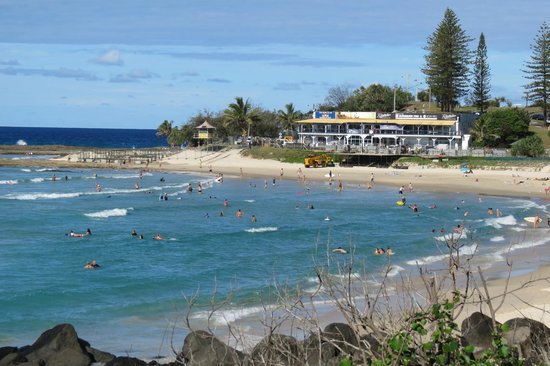Rainbow Bay SLSC

Rainbow Bay Surf Life Saving Club (SLSC) was established in 1962 due to the growing population and families finding Rainbow Bay a safe place to swim and a great place to surf.
Rainbow Bay SLSC is the most southern club on the Queensland coast and is positioned on one of the Gold Coast’s only north facing beaches, providing sheltered conditions for swimming. There are picnic tables, kids playground, public BBQs and toilets. Volunteers patrol the beach every weekend from September to May and Gold Coast City Council Lifeguards patrol the beach outside these times.
The clubhouse offers its members a training area, showers, change rooms and large equipment area. Rainbow Bay SLSC upstairs area is run by the Supporters’ Club.
Our Supporters’ Club deck is the perfect spot to relax, have a beer and watch as the waves roll in the distance and the sun sets over the hinterland. We have membership types to suit many requirements. The club offers a great community service for all age groups and welcomes the public to come and enjoy the facilities at Rainbow Bay SLSC.
Rainbow Bay
Situated north of Point Danger, Rainbow Bay is a favourite with families and holidaymakers. It’s also the gateway to Snapper Rocks where you can find the best point breaks barrels on a south-easterly swell.
Rainbow Bay and adjoining Snapper Rocks Beach are the southernmost beaches in Queensland. Rainbow Bay (1600) is a relatively small, 300 m long, north facing beach that is bordered in the west by Greenmount Hill. It ends at a low, rocky point, beyond which Snapper Rocks beach (1601) continues on for another 100 m to Snapper Rocks; part of the larger 30m high Point Danger that forms the border with New South Wales.
The Rainbow Bay Surf Life Saving Club is the newest on the Gold Coast, being formed in 1962. It is located on the low, rocky point that separates the two beaches. A road runs along the back of both beaches, ending in a parking area behind Snapper Rocks Beach. There is a grassy foreshore reserve behind Rainbow Bay Beach.
Both beaches receive waves that are lowered after moving around Point Danger to an average of about 1m. The width of both beaches and offshore bar conditions depend on both the prevailing waves and, in particular, the status of sand waves moving around Point Danger. When the bars are present, the beaches are connected by sand, there is a wide surf zone and excellent surfing conditions. When the bars are absent, the beaches are separated by the rocky point, are narrower and there is an attached bar cut by one rip at Snapper Rocks Beach and two at Rainbow Bay. Low rocks dominate the Snapper Rocks surf zone and are a hazard for swimmers.
Location
2 Snapper Rocks Road,
Coolangatta QLD, Australia